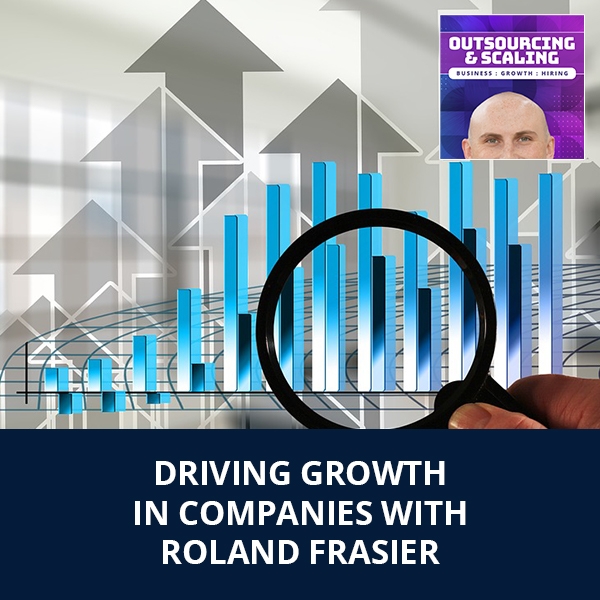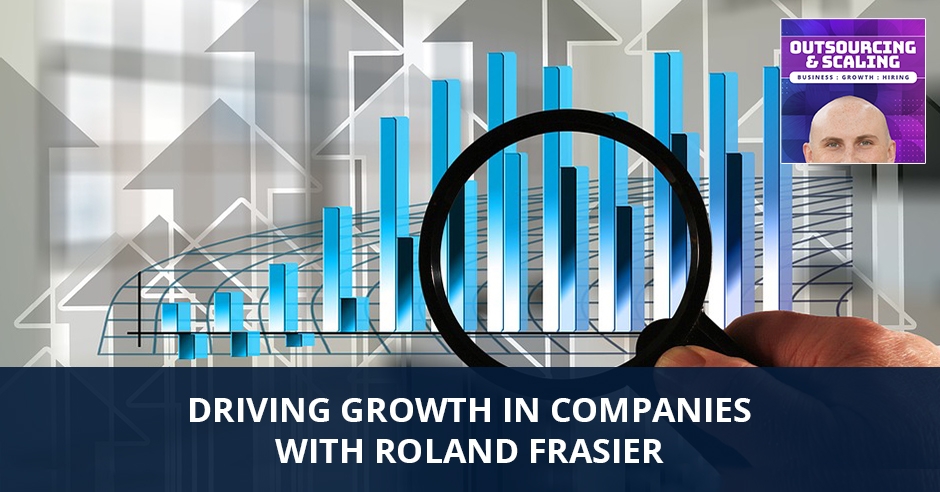


—
Listen to the podcast here:
[smart_track_player url=”https://www.podetize.com/statsapi/www.podetize.com/wp-content/uploads/fileuploads/11-5b145ef137b51b3d1af0633e9305c43d/08/2019/d1235520943044d6ea0a28f323e4118d.mp3″ title=”Driving Growth In Companies with Roland Frasier” artist=”Nathan Hirsch” image=”https://freeup.net/wp-content/uploads/2019/04/OAS.png” ]
Download the audio file here.
Driving Growth In Companies with Roland Frasier
My special guest is Roland Frasier. Roland, how are you doing?
I’m great, Nathan. How are you?
I’m doing great. Where are you joining us from? I know you are traveling.
I am in beautiful Austin, Texas. I’m here for board meetings for a couple of our companies.
For those of you that don’t know, he’s a Cofounder and Principal of three current Inc. Magazine fastest-growing companies. He’s founded, scaled or sold 24 different seven to nine-figure businesses ranging from consumer products to industrial machine manufacturing companies with adjusted sales ranging from $3 million to over $300 million. You might know him from DigitalMarketer running the Traffic & Conversion Conference. We’ve been talking for a little while. We want to go all into that. First, let’s take a gigantic step back. What were you like as a kid? Were you a rebel? Were you a straight-A student? Did you know that you wanted to be an entrepreneur?
I was a straight-A student, but I was also a straight-F student because I’ve always had a challenge with authority. I have had ups and downs in the academic world. I would say rebel, but I wasn’t like a crazy rebel if that makes any sense at all.
Did you go to college? Did you graduate from college?
Yeah, I did the whole thing. I graduated from high school. I went to college. I got a degree in accounting. I went to law school and got a degree in law. I went to advanced law school for an advanced law degree.
If you don’t want to be in the company when you sell it, you need to have people who will replace you.
What was your first entrepreneurial endeavor after that? Did you go out and get a real job or you go right into entrepreneurship?
No, I was in entrepreneurship from an early age. From about sixteen doing different things, eighteen, I got my real estate license and started selling real estate. At nineteen, I got my insurance license. At twenty, I got my securities license. I was doing what they call private placements or syndications, raising money, putting together real estate deals and stuff like that all through doing the academic stuff. I also played in a band during that time at night. I played out in clubs from about age 15 to 42. I stopped when I was 42.
What was your first outside of college when you were like, “I’m going all-in with this entrepreneurship,” or was that right away?
I was an entrepreneur the whole time. I’ve always been passionate about business. I had a law degree so I figured why not practice law, but I was buying and selling companies. By that time, I started with buying and selling real estate and moved into buying and selling companies when I was in my twenties. As I was in law school, I had got offered three different jobs with the Securities and Exchange Commission divisions and decided that I wanted to go and practice for myself. I opened a law firm, another entrepreneurial venture and grew it to be one of the top firms in San Diego, California which I had moved to from Virginia. Basically, I had so many deals going on that it seemed like it made a whole lot more sense. I made a lot more money doing those things than practicing law plus it’s a whole lot more fun to do deals than it is to do lots of stuff.
A lot of people know you from Traffic & Conversion from a DigitalMarketer. Can you tell us that story? How did you get into that? What is your role now with them? I know that’s changed over time.
I’ve always been a big believer in if you want to get to know somebody that you want to do business with, find the paid channel for access that they have already created because you will go in as a customer, meaning that you will go in a position where they want to serve you. I went to this event called Traffic & Conversion Summit that these two guys, Ryan Deiss and Perry Belcher, were holding for the first time. It was 2008. It was amazing, I thought it was fantastic. They have this mastermind called War Room that sounded interesting, but I didn’t know enough what it was. I didn’t join it. I went back the next year because I was regretting the whole time that I hadn’t joined it for the following year with the intent of signing up right away.
I went up to the thing as they were signing into the desk because they were setting up everything and said, “I want to join that War Room mastermind.” They said, “You can’t.” I was like, “What do you mean I can’t. Is it sold out? What’s going on?” They were like, “We haven’t printed the forms yet.” I was like, “Okay.” I joined that. I was a member of that for about three years. We got to be friends, Ryan, Perry and Richard Lindner, who was another partner in the business. We got to be friends and there was an opportunity to become a partner when they had a CEO who had a big chunk of equity options that ended up becoming available.
They said, “Is this something you’d be interested in being a part of?” I said, “Yes.” I ended up buying in. I’ve had the journey with DigitalMarketer, Traffic & Conversion Summit and War Room, which are three separate companies, but all involving those people for several years now. I’ve been a fan, customer, member and partner. That’s the evolution. We’ve exited three companies that the group owns. We went through a partner buyout where we bought out Perry from the DigitalMarketer companies. Perry bought us out from the eCommerce companies. DigitalMarketer is Ryan Deiss, me and Richard Lindner. Traffic & Conversion Summit was one of the companies that we exited part of. It’s going into 10,000 people in San Diego in 2020. We’re doing in June of 2020, Amsterdam for our first European expansion. We’ll have about 3,500 to 4,000 people. In October, we’re doing Singapore for our Asia expansion. We’re focused on growing those companies super-fast and big.

You’ve obviously hired a lot of people. What is your hiring mentality when you’re looking to add people to the team to build a company to eventually sell it? What are you looking for?
One of the things that are important to valuation and the ability to sell is that if you don’t want to be in the company when you sell it, you need to have people to replace you. If you are a personal brand, you can’t sell a personal brand. It’s almost impossible. If you can, you’re not going to get that much for it because it’s you. One of the biggest things for anybody who’s an entrepreneur to do is to say, “I’m not going to make the company me. I’m not going to name the company me. I’m not going to do anything except being the spokesperson for the company. I need to get operators and personnel in the company that can do all of the things that need to be done. If not, I don’t get to work on the company because I’m working in the company. I don’t get to sell the company because the company is still me.”
What I look at when I come in is, who are the professionals that we can bring in to do all the things that need to be done, create something that someone else can buy and be an owner of without being an operator of because that’s where the money is. The money is in private equity firms, investment banks, companies that want to buy a company to add something more to it. They don’t want a company that’s you. You need workers in all of those companies. We’ve had in the DigitalMarketer Group of Companies as many as 300, probably close to 325, 350 people at one point. We’re 62 people in DigitalMarketer. We’re probably a total of maybe 75 or 80.
Do you have a bad hiring experience? Maybe a hiring horror story that you can share with the audience?
We’ve had people that we hired that were crazy but those crazy people ended up in lawsuits that settled, that I can’t talk about. I’ve had experiences with people where usually everything is communications. The big thing is that you want to be very careful as a person who’s being hired or as a person who is hiring others to be clear on what is the compensation, what’s the expectation that’s being created? Are there promises that are being made? We’ve had people that relocated. If somebody is moving from a place to another, that’s an expensive life uplifting thing. You’ve got to have some responsibility as an employer to be careful to not uproot people’s families and have them move and say, “It didn’t work out or we changed directions. Sorry, we don’t need you anymore.”
At the same time, you’re not signing somebody on for lifetime employment. The key is communications to say, “Here’s the position, here’s the job description.” That’s a key one. You need to write a job description before you hire somebody so that they know and you know what they’re supposed to do. You need ideally to have them come into a position that already has SOPs, Standard Operating Procedures and processes. If you don’t, bring them in with the expectation that that will be part of their job to create those so that if they move on or up in the company, somebody else can come in and know what they were doing and on the comp package too.
We’ve had people who came in and there were conversations about all kinds of variable comp. People come in and it’s like, “Can I get a piece of the company?” “No, you can’t. We don’t do that.” “Can I have a variable comp where I get paid a certain performance, fee-based on this?” “Probably let’s talk about that.” When you talk about it, you’ve got to write it down. As a recovering attorney, I can tell you that people hear different things without either of them being liars, cheaters or thieves. You can have a conversation with somebody, you and I can have a conversation about a deal even and say, “Nathan, I’d like for you to do this. Here’s the thing.” You hear something. I said something differently. That’s what makes people fight with each other. That written understanding of that is important. It’s the same thing with benefits and culture. I think that for us, we lean heavily on the side of providing a lot of benefits because we want our people to feel taken care of.
We don’t cut deals for somebody going to be scraping by and the comp package, if we can’t afford to pay them what they need to make things work for them, we don’t hire them because you’re setting yourself up and them for failure. In terms of the breakup, how do we determine what happens if things don’t work out? That’s ideally agreed on in advance as well. We have a standard severance package or something like that or, “We’ll pay you for two weeks or four weeks,” or whatever the deal is. It’s getting all that stuff that people gloss over. One of the biggest things for litigation is that you’ll get into a business, we had a partner in one of our portfolio companies that had conversations with somebody and they thought they were entitled to X amount of money per certain transaction that happened. When things didn’t work out and they left, they file a lawsuit for however much money saying, “We generated all these things. I’m entitled to all this money.” That never happens if you’ve got all that stuff in writing.
You can’t sell a personal brand. It’s almost impossible.
What about the culture? I know you’re someone that has a lot of meetings. You have a lot of different companies. Are you building the same type of culture in every single company or are you customizing the culture for that company?
The answer is that there are similarities, but every company has its own culture. Culture can’t be cookie-cutter copied and stamped out in different environments because there are different people in a software company than there are in a real estate sales company that is different from people that are in eCommerce company. Even from one company to another, the people will be different. What we do is we get together and my partner, Ryan, is excellent at this. We create a set of things that we call the “We Beliefs.” We say, “What are the beliefs of the company? What are the things that we stand for?” We have a thing called a character diamond that’s basically if the company was a human being, who would that company be?
What’s the hill that it’s prepared to die on the North Star? What’s the counterpoint to that? What’s the one thing that we hold sacrosanct that will not bend on? The other side is, “What’s our quirky thing that some people might not like, but it’s a defining thing for us?” Once we identify that, we say, “Based on that, what do we believe should happen?” We go through a whole exercise of that and every company we do. We create a video that’s an indoctrination video for everyone who’s in the company and everyone who’s in the company participating in the process is in the video. That video is shown to everybody that’s a prospective hire so that they know what they’re getting themselves into.
What about running a meeting in general? Is there a certain format you have for running meetings with different teams?
I like to have an agenda outline. That’s basically it. An agenda outline is, what do we hope to accomplish at this meeting? What are the basic points that we’re going to have to cover that are critical to moving forward to accomplish the thing we want to accomplish? As you get into the meeting, I tick those things off. I like to say, “We finished issue number one. What are the action steps? Who’s supposed to do what within what period of time and when are we going to follow up to see what’s happening?” That and then we use a software program called monday that is an OKR, Objectives and Key Results software. We follow the John Doerr’s Measure What Matters monday, OKR Andy Grove philosophy.
If you go to the FreeUp Facebook group Outsourcing Masters and FreeUp YouTube video, we have a video using monday on how you can use and organize freelancers using that tool. What about figuring out how much to spend on hiring? A lot of entrepreneurs as they scale, they struggle with this. Do you have a certain percentage of revenue or profit that you’re figuring out? How much should I invest in people for my business?
It depends though. Any general rule is subject to exception. Generally, we like for payroll to be no more than 20% of sales. If we’re doing $1 million, we should have about a $200,000 payroll. If we’re doing $10 million, we should have about $2 million payroll. If a company is in a growth phase, that’s a different animal or you’re doing a dev thing with software or something like that because you may have ramp-up expenses. Once you’re an operating company, it’s fair to say ideally you’re in that 20%, 25% range. Try not to go over that. As far as what individual people get paid, there’s Glassdoor and places like that so you can look and see what does this position pay in this particular location? What you pay people should be what the market rate is. There shouldn’t be a whole lot of guesswork to that. There is a range that you can look up that has statistically been determined because thankfully other people have hired people like you’re going to hire for similar positions in the past and recorded what that is. You’ve got a database and things you can look at.
You have different business partners in this business. I know you talked about Ryan. What do you look for in a business partner?

It’s somebody that I like. One thing you learn as an attorney is that people don’t sue people they like even if those people make big mistakes. You’re going to spend a lot of time with a business partner. If you have somebody that you have any doubts about, whether you like them or whether you can hang out with them outside of business, it’s probably not going to work. Anytime I can look at throughout all of the things I saw as an attorney or all business relationships I’ve had that didn’t work out in some way, it’s personality differences. It doesn’t mean those people are bad or wrong or anything. It’s just you like who you like. The first thing is you’ve got to like them.
The second thing is that you need to have complementary skills. If you’re good at operating a company or you partner with somebody else who’s good at operating a company, you’re probably going to butt heads because you have different operating styles. You need to think about the attraction model of visionary integrator. They say there are people who are visionaries who have the idea of where the company’s going to go and there are integrator people who make that stuff happen. That’s a good pairing. Ryan, my partner, has a thing where he says there are inventors, builders, generals and guides. A guide is somebody that’s not in the company managing, that’s more of a CEO outward facing person. The general is the integrator-operator that’s like the COO who’s running the show, but they’re also builders.
Operators aren’t necessarily the people who can invent the things or come up with the ideas. They’re not necessarily the people who can build those, but they can operate them once they’ve been built. I had a talk with Clate Mask, who founded Infusionsoft, which is now Keap. As they’ve gone through $100 million-plus in sales, he had a good point and that along the way, there are different people that you’re going to come into contact with. A partner can’t be somebody who’s not willing to change, grow and dedicate to personal development along the way. When you found the company or get into a company and you’re at $100,000, $300,000, $1 million, $3 million, $10 million, $30 million, $100 million or $300 million. Each time you hit one of those new thresholds, the people that you’ve got aren’t going to be qualified to get you to the next threshold, the people in senior management in particular.
As a founder, you’re the exception if you are on an aggressive personal growth path because you do have the vision of the company and ideally you step out of the things that you can partner with are hire or contract out that are not your skills. You’re developing new skills all the time. You’re committed to honing the skills you’ve got. Your partners have to be in that mindset as well. I’ve seen three companies that went through partner buyouts because one partner was not committed to that or one partner had a different vision or whatever. You want to be sure that you’re aligned. You want to be sure that you like each other. You want to be sure that you can have fun together. If your meetings are knocked down drag outs or if you’re arguing about what flowers should we have on the desk, that’s probably not a good partner.
Let’s talk about sales and marketing. That’s obviously been a big part of your scaling and growing. What’s your mentality when it comes to those two and how do you see things changing?
I am for both sales and marketing. It’s important to have a sales function. It’s something that is probably the weakest thing in our business because we are good marketers. If you say there’s 20% that we’ll never buy and 20% that will buy anything that you do. The other 60% is where the money is made. We’re not good at getting the 60% without bringing in an outside group because we’re marketers, we’re not salespeople. Knowing that marketing to generate inbound for sales and sales to convert the leads that you’ve got an important combination and very frequently those two don’t get along. The people that are marketing are sending all kinds of leads to sales and saying, “Why aren’t you converting more of the leads?”
The salespeople are saying, “The leads aren’t converting. Why aren’t you sending better leads?” The salespeople go back and say, “Maybe if you followed up with them a few times or got back to them immediately, it would be better.” It’s back and forth and back and forth. The perspective of marketing and sales and what’s happening in that is that they are coming more and more together. More salespeople are having to embrace marketing technology and become at least familiar with marketing. More and more marketers are moving into sales as they realize that the best way for them to maximize their efforts or to optimize their efforts is to be able to convert that 60% that they’re leaving on the table right now. They need to be familiar with and understand how sales work to better integrate the two. Ultimately, you’re going to have smarketing, which is sales and marketing together.
What about conversions? What are some of the biggest mistakes you see when entrepreneurs are trying to convert and can’t get it done?
Conversion across the customer journey is much deeper than clicking the buy button.
It’s converting people to sell on a website or something like that.
It could be any eCommerce trying to convert clients. It could be an agency trying to land that client or get a client back. What were some common mistakes you see?
It’s a couple of things. One, it would be that they’re focused on the wrong thing because conversion across the customer journey is much deeper than, “Are they going to click the buy button on my website right now?” It’s a failure to address customer experience. If you look, it’s about 89% of all Fortune 500 CEOs right now say the biggest thing that they’re focused on going forward is customer experience. Customer experience is the number one thing that you can differentiate yourself from other people in a world of homogenous products or fungible products where people are going to China and buying the same 67 versions of something, putting them on a website and putting them for sale. That’s ultimately not going to be successful going forward.
The little tiny conversion hacks, that’s probably what I would say is people are focused on conversion hacks, which are temporary and disappear the moment that everybody else knows the hack and those go away. They’re immersed in the hacks so they ignore product, market fit, product development, customer experience. Because they’re after those new customers, they’re also ignoring their existing customers who have been proved through study after study to be worth five times the value of a new customer. The conversion thing is to focus on hacks and not on the bigger things that matter.
You’ve sold a lot of businesses and you’ve been a part of mergers, what advice do you have for entrepreneurs who are looking to sell their business?
There are a whole lot of factors. I would say that the things to think about are you have three different ways that businesses typically get sold. If it’s a small business that’s dependent on you, it usually sells for what you’ve taken out of the business in the last twelve months. It’s called Seller Distributable Earnings or Seller Distributable Cash, SDE or SDC. It means if you have a business that’s doing $1 million a year and you’re making $100,000 a year out of it that you take out of the company, you’re going to get paid $100,000 for it.
The next way that companies get sold as if they’re a little bit bigger if they have that bench depth so that they’re not a personal brand and they’re not totally dependent on you. You’ve got no one customer that’s more than 20% of your customers. You’ve got 20% year over year compound annual growth rate. You’ve got standard operating procedures and processes and those kinds of things. You’ve got some ideally defensible IP, Intellectual Property and some competitive advantage. You’ve got a good share of your market that’s trending up. If all of those things are in play, typically you’re going to sell for a multiple of your earnings.
Generally, it’s called EBITDA, which is Earnings Before Interest, Tax, Depreciation and Amortization. In that same business that was doing $1 million, that had a profit of $100,000 before that you only sold for $100,000, this one might sell for a multiple of seven times that $100,000 profits. Now you’ve got $700,000. The other business is a recurring revenue business. A recurring revenue business typically sells for a multiple of sales. In that same business and this would be a Software as a Service as a perfect model, but any other subscription thing with monthly recurring revenue or annual recurring revenue where the revenue comes in every month. You’ve got a reasonably low turn, ideally under 5% and you’ve got a 20% compound annual growth rate, etc. You’re probably looking at a multiple of sales.

That same multiple of say seven that we talked about on the $100,000 now goes towards $1million and you’re going to sell that company for $7 million. You need to say, “Do I want to be a small company where I’ll only be able to sell it for whatever I’ve taken out in the last twelve months? Do I want to build it a little bit, have some freelancers, some infrastructure and spend some time developing the skeleton of the company and sell things one at a time, in which case I’ll probably get a multiple of that? Do I want to create a recurring revenue company where I’m likely to get a significantly bigger bump? I’d say that’s the first place that you need to think about who do you want to be and how do you want to position yourself for sale. All of the things that I mentioned casually, quickly in passing, those are all things you have to focus on when you’re thinking about preparing a company for sale.
Where can people find out more value and what are you most excited about for the rest of the year?
I have a podcast also called Business Lunch. That’s a good place to listen to a lot of stuff for me where I talk just me and also interviewing people like you. I am on all the socials, @RolandFrasier. I have a website, RolandFrasier.com, DigitalMarketer.com and our big event, TrafficandConversionSummit.com, those are all places to connect.
Thanks again.
Thank you. I appreciate it.
Important Links:
- Roland Frasier
- Traffic & Conversion Summit
- War Room
- monday
- Measure What Matters
- Outsourcing Masters – Facebook Group
- FreeUp YouTube video – monday.com Quick Demo Tutorial Project Management Software
- Keap
- Business Lunch
- @RolandFrasier – Facebook
- RolandFrasier.com
- DigitalMarketer.com
- TrafficandConversionSummit.com
About Roland Frasier
 He is co-founder and/or principal of three current Inc. Magazine fastest growing companies, and he has founded, scaled or sold 24 different 7 to 9 figure businesses ranging from consumer products to industrial machine manufacturing companies with adjusted sales ranging from $3 million to $337 million.
He is co-founder and/or principal of three current Inc. Magazine fastest growing companies, and he has founded, scaled or sold 24 different 7 to 9 figure businesses ranging from consumer products to industrial machine manufacturing companies with adjusted sales ranging from $3 million to $337 million.
